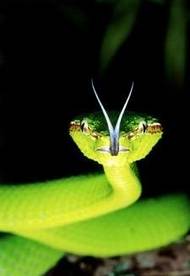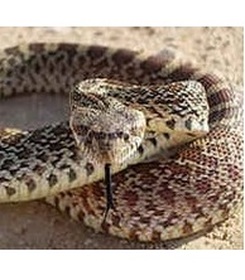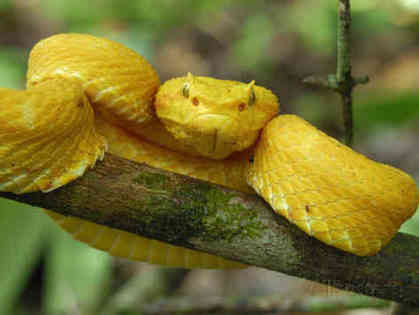Meet the Pit Vipers |

Custom Search
|
|
The pit vipers group of snakes includes some of the most beautiful and most venomous and dangerous snake species in the world. These snakes are excepcional predators and hunters, and possess some amazing evolutionary adaptations to help them find and kill their unfortunate prey.
This group of snakes includes very well-known species such as the copperhead, rattlesnakes, and the cottonmouth or water moccasin. If you want to learn more about the pit vipers, sometimes called crotaline snakes or pit adders, read on to find the answers to all your questions. So what is a pit viper? Let me start by the fact that all pit vipers belong to the Viperidae family, but not all snakes that are members of Viperidae family are pit vipers. The pit vipers are considered as a subfamily of the Viperidae family. For example the gaboon viper (Bitis gabonica) found in Africa is a viper but not a pit viper on the other hand the golden lancehead (Bothrops insularis) is a pit viper only found in a tiny island of the coast of Brazil. To understand the difference we need to analyze the term "pit viper". The members of the Viperidae family of snakes are known as vipers, but some vipers also possess heat-sensing pits located between the eye and nostril, hence their common name pit vipers. These pits are thermoreceptors capable of detecting minimal temperature differences, which helps them track and hunt their warm-blooded prey. Some python species like the carpet pythons found in Australia have somewhat similar heat-sensitive organs to help them locate prey in the dark. Where can we find pit vipers?
The pit vipers are widespread and can be found in most continents, except in Antarctica for obvious reasons, Africa and Australia. They are found in North and South America, Asia and even parts of the European continent. The many pit viper snake species have adapted and inhabit a wide variety of habitats, from deserts, forests to jungles and are capable of surviving in habitats farther north and south of the equator than most other snakes. There are arboreal and terrestrial and even semi-aquatic species like the Cottonmouth (Agkistrodon piscivorus). Some pit vipers can be found at high altitudes like China’s Tibetan Pit Viper (Gloydius Strouchi), found at elevations over 4000 meters. Surprisingly Australia which is home to some of the most venomous snakes in the world like the inland taipan, is not inhabited by any pit viper species. How big can pit vipers get?
The South American bushmaster (Lachesis muta muta) is the largest of all pit vipers and can reach a length of 12 feet (3,5m), the smallest pit vipers only reach around 2 feet (60 cm). But on average pit vipers are between 3 and 5 feet long (90 to 150 cm). How do pit vipers reproduce? For the most part pit viper are ovoviviparous snake species, meaning that they are livebearers and give birth to live baby snakes. The few egg laying pit vipers or oviparous snakes, include the Bushmasters, Malayan pit viper and some species of bamboo viper. The brood size is quite variable and can be as small as 2 hatchlings for smaller pit viper species or as high as 85 for the fer-de-lance (Bothrops Atrox), the most prolific of the live bearing snakes. Are all pit vipers venomous and dangerous to humans?
In a word YES, all pit viper snake species are venomous, however their type of venom and its toxicity varies greatly from species to species. Are all pit vipers dangerous to humans, in a word NO. For instance both the Copperhead (Agkistrodon contortrix) and the South American bushmaster (Lachesis muta) are considered pit vipers, but their venom's potency is quite different. Although there are very few documented deaths from copperhead bites, a bite from even a juvenile South American bushmaster can be fatal. How many species of pit vipers are there? Taxonomy, which is the way scientists classify animals is an ever changing subject. In the current pit viper subfamily classification there are 18 genera and 151 snake species. Here is a list of all pit viper Genus, common names current number of species and where are they found.
|
Did You Know?
A recently discovered fossil snake was 49 feet long, longer than a school bus! Meet the Titanoboa. |







